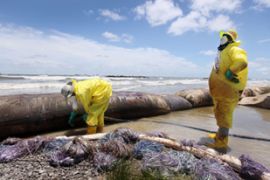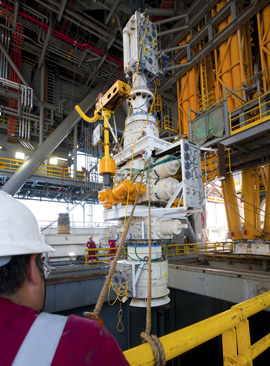BP begins testing new oil well cap
Government gives go ahead for tests amid hopes cap can seal gushing Gulf of Mexico well.

| in depth | |
|
BP first delayed the procedure on Tuesday after consultations with scientists and engineers from the industry, government and the oil company.
Officials said they were running more analysis on the cap before trying to close the wellhead after previous efforts to halt the worst offshore spill in US history failed.
Pressure
US officials had feared that if the pressure caused by shutting off the flow of oil increases too quickly, it could send oil shooting up from a new leak on the sea floor.
The latest cap is only meant to be a temporary fix, but if it can withstand the pressure, the leak would be halted, easing the urgency put on BP to finish drilling a relief well and concrete the site over to permanently stop the flow.
 |
| Engineers hope the new cap deployed on July 11 can seal the leak [Reuters] |
John Terrett, Al Jazeera’s correspondent in Louisiana, on the Gulf coast, said scientists were very concerned about the pipe as no one knows what state it is in.
“The precise concern is that one of the new relief wells, which are thought to be the only guaranteed way to stop the gushing oil, is so close to the existing and possibly damaged bore hole that should there be some kind of rupture or break in its integrity it could damage the well,” Terrett said.
Turning point
The tests, which could mark a turning point in the massive environmental disaster, are expected to last between six and 48 hours.
If they progress as hoped, BP said no oil would flow from the well for the first time since a rig being drilled for BP by Transocean Ltd sank days after an April 20 explosion that killed 11 workers.
During the tests, two smaller siphoning systems will be turned off. However, BP warned the outcome was uncertain since the system has never been tested at such depths.
The leaking wellhead is about 1.6km underwater. The new cap was custom-designed and built for the leaking well.
If the cap is not sealed, BP intends to contain the whole of the oil flow by mid-July by siphoning it off through pipes to ships at the surface.
The only proven way to permanently kill the leak lies in the drilling of relief wells to intercept the ruptured one.
The first of two such wells started in May is expected to intercept it by the end of July and plug it with drilling mud and cement by mid-August.
